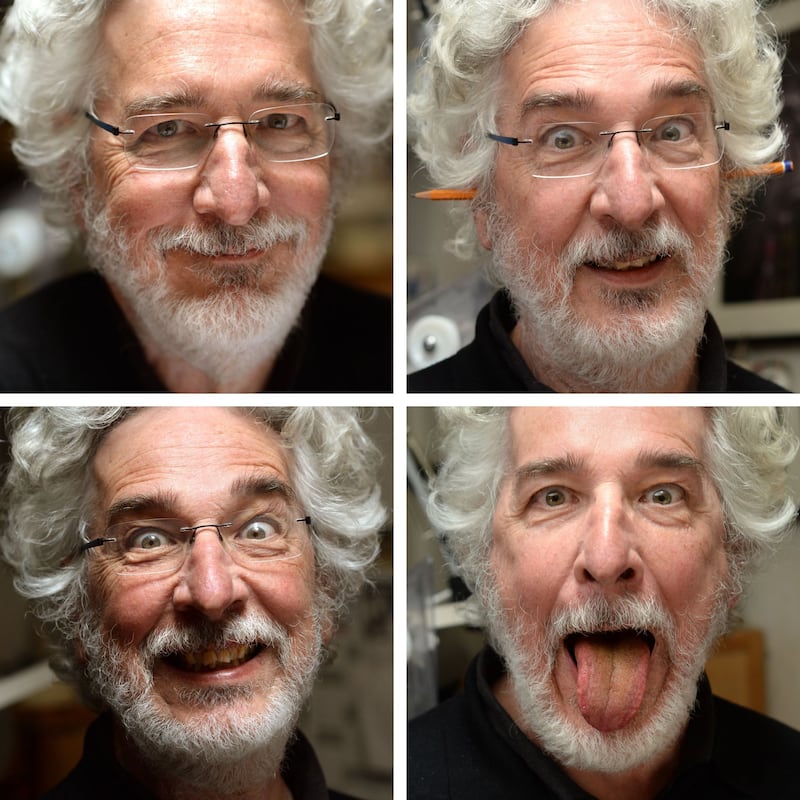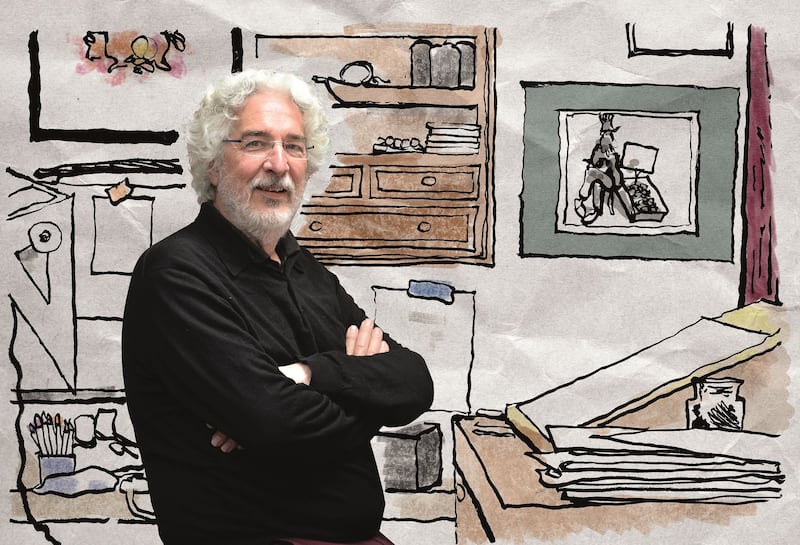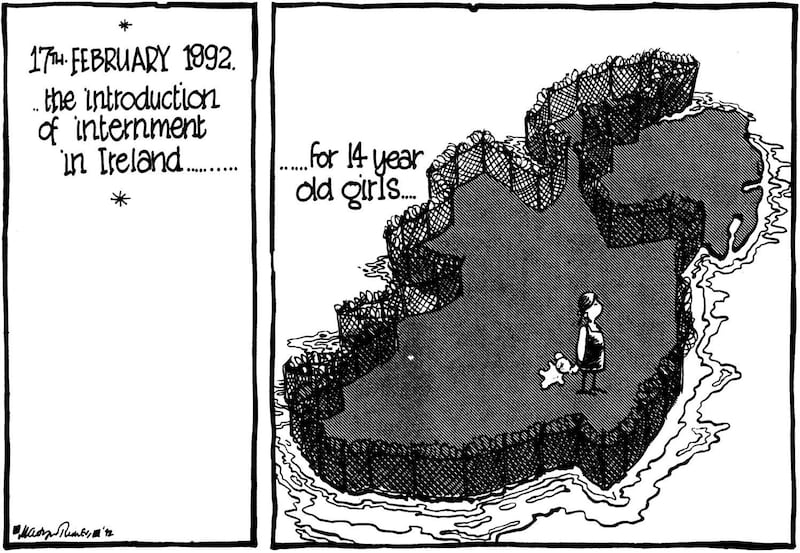Martyn Turner is at his drawing board, brush in left hand, inking an addendum to the Irish Times guide to common garden birds that satirises vulture-like law professionals, cuckoo funds and the recently chosen leader of the DUP. "Do you think The Irish Times will allow me call Edwin Poots a Wee Orange Tit?"
Turner is nearly 73, and his first Irish Times cartoon was published 50 years ago this weekend. He is a satirical genius.
Martyn Turner's love of print started in primary school, where a teacher and local journalist called Ms Cook encouraged the pupils to create a paper. In secondary school he produced an 'anti-school newspaper' pseudonymously
He is tall and bearded and has colourful clothes and, currently, a shock of grey hair. “I said to Jean [his wife], ‘The Irish Times are coming out on Thursday’ and she said, ‘You should get your hair cut’ and I said, ‘Oh no, they might want to take photographs and it would be much funnier with my hair like this.’”
We’re sitting in a refurbished cowbarn connected to their house a few kilometres outside Naas. It’s Turner’s studio. There’s an exercise bike in the middle of the room (“Wasted on us”) and a Duracell bunny stuck to the half-door. Ollie, an exuberant red setter (their 22nd red setter to date), has been expelled for the duration of the interview. Turner draws on paper and then scans his work on to a computer in the corner, where he adds colour “sparingly”.
His collection of cartoon books is smaller than it once was but there are still loads on the shelves. He has donated most of it to University College Cork (and while I’m there, he donates one book to me). His own older cartoons went to the National Library of Ireland. He has, over the years, published 20 books himself. On his shelves I see copies of The Whole Earth Catalogue, Art Spiegelman’s Raw, Alan Moore’s Watchmen and Goscinny and Uderzo’s Asterix.
The walls are lined with pictures by Erich Sokol, Clay Bennett, Hunt Emerson, Roy Peterson and more. By his drawing desk there's a painting of Neil Young by Sebastian Krüger. The international fraternity of cartoonists all know each other and swap pictures at festivals such as the Guinness International Cartoon Festival, which Turner ran with the late Terry Willers in the 1990s.
He and Jean have lived here since 1976, the year he got his first full-time contract with The Irish Times, buying the property with money from Jean’s father and her bank in Slough – Jean had a real job as a librarian – after a bank manager at EBS rejected him. “I said, ‘I’m a freelance political cartoonist.’ He just started laughing. Which I thought was great. Nobody ever laughed at my cartoons.”
Turner’s love of print media started in primary school in Essex, where a schoolteacher and local journalist called Ms Cook encouraged the pupils to create their own paper. In secondary school he produced an “anti-school newspaper” pseudonymously.
“Fifty years later I met the guy who was the manager,” he says. “I was responsible for all the writing and the drawing. He was responsible for selling it. He said to me, ‘We made a great profit.’ I didn’t remember any money. But it’s nice to know I worked at a newspaper that actually made a profit. I don’t remember working on any other newspapers that managed to make any money.”

He was a scholarship boy at Bancroft’s public school in Woodford Green, on the northeast edge of London, which he hated. He had wanted to go to Leighton County High because the footballer Phil Woosnam was the chemistry teacher, but his mother (“she kind of lived her life through me”) insisted on public school.
“There were two places for poor boys … I got one of the two places and it was hideous. So when I applied for university, I applied for all the ones as far away from the school as was physically possible.”
This is how he found himself studying geography in Queen’s University Belfast in the late 1960s. Did he know much about Ireland? “I had never heard of Ireland,” he says. “You can live a whole life in England without hearing the word Ireland ever mentioned.”
At Queen’s he edited a general interest magazine called Interest. Then in 1970 he became a cartoonist on the non-partisan political magazine Fortnight, before later becoming its editor when “the guy who started it decided to go off and write the constitution of New Guinea”.
At Fortnight, Turner had friends on both sides of the political divide. Being an outsider is useful for a cartoonist, he says. “I don’t have any baggage. I’m not Protestant or Catholic. I’m not a unionist or a nationalist. I don’t give a fig for either of them really. And when I came down here, I wasn’t Fianna Fáil or Fine Gael. They both seem equally daft to me.
“It’s quite handy to be of the culture but outside the culture. It’s quite common in cartooning … A lot of the British cartoonists are Australians … ‘Vicky’, the other great British cartoonist, was Hungarian.”
I used to do a lot of lines because I used to figure the more lines I did, the more they'd think it was worth paying money for … If I had a very simple style, you'd think: Well, anyone can do that
He began contributing cartoons to The Irish Times in summer 1971. When he joined the paper officially in 1976, after five years of sending cartoons down on the train, it had, to his knowledge, never had a full-time political cartoonist.
“They had a lovely pocket cartoonist in the 1960s called NOK [Niel O’Kennedy]. I met him one day on the street, and he told me that he stopped because when he got middle-aged he suddenly started seeing other people’s point of view.” He laughs. “Which is something I’ve never suffered from. I’ve always been a liberal bigot.”
Turner is instinctively self-deprecating. I ask him about the evolution of his style. “My secret is I can’t really draw,” he says.
I tell him I love the way he scratches and shades his work and he says, “I used to do a lot of lines because I used to figure the more lines I did, the more they’d think it was worth paying money for … If I had a very simple style, you’d think: Well, anyone can do that.”
He resists any attempt of mine to elevate cartooning to a higher plane. When I paraphrase a Steve Bell quote about how it’s a cartoonist’s job to “go too far”, he laughs and says: “A cartoonist’s job is to feed his family.”
In the early days cartoonists were so low in the hierarchy, people would just cut up the original cartoon to fit the page, he says. “Cartoons would come back in pieces … Once I went in to [The Irish Times] and there was a hushed silence and a pompous subeditor came up and said, ‘I really liked that cartoon you did the other day. I decided I’d have the original, so I took it home. Here’s a pound for yourself.’”
So cartooning is a slightly disrespected, disgraceful branch of news media? He laughs. “Well, I hope so.”

Cartooning is much more respected in Europe. He tells me about sitting in a Parisian cafe with Steve Bell from the UK and Eric Rauschenbach from Germany. “Steve said to me, ‘How’s your book going?’ And I said, ‘Fine. We printed 5,000 and we’ve almost sold out.’ I said, ‘What about you?’ And he said, ‘We printed 9,000 and about half of them are gone so far.’ We said to Eric, ‘Have you ever had a book out?’ and Eric said, ‘The last one sold a quarter of a million.’ ”
What’s it like when someone new comes to the forefront of politics and he has to figure out how to draw them? He puts his head in his hands and whispers in despair, “I can’t draw … I remember after Bertie [Ahern] took over, [Irish Times colleague] Pat O’Hara used to send me text messages or emails saying, ‘Almost … Almost’ and after nine months of drawing Bertie every day he said, ‘Yes.’ ”
He likes finding little details he can use as shorthand. He stuck a cigarette in Brian Cowen’s ear. He drew Haughey with a fish in his pocket after his boat capsized. The little worm that frequently turns up in the corner of his own frames was an attempt to fit in extra jokes.
“The editors who hired me left The Irish Times and then [Douglas] Gageby came back,” he says. “We were thick as thieves when he left but initially he wasn’t very keen on me because he didn’t approve of what I wrote in Fortnight. I was far too non-republican for his liking … So I’d make the cartoon reasonably bland so Gageby wouldn’t get upset but then I’d put this little thing in the corner, which is what I really wanted to say. Then I was in the office one day, and Gageby said, ‘You know what I really like about your cartoons? I like that little thing in the corner.’ ”
I met PJ Mara once at a do. I said I'd just got asked if I'd like to go and work in Scotland but it's a lot of upheaval and I really like The Irish Times. Mara said, 'If you're thinking of moving we would probably pay your removal expenses'
People didn’t always take kindly to his work. In 1995 he was unsuccessfully sued for blasphemy for a cartoon he drew featuring Christ during the divorce referendum. Charles Haughey kept trying to get him sacked, he says.
“I met PJ Mara [Haughey’s adviser] once at a do, and Mara asked did I ever get any offers from any other newspapers. I said, ‘Funnily enough I just got asked if I’d like to go and work in Scotland but [it’s] a lot of upheaval and I really like The Irish Times.’ Mara said, ‘If you’re thinking of moving we would probably pay your removal expenses.’ You could never tell with him if he was being serious.”
Does he get many complaints? He doesn’t know. The woman who once fielded the calls at the newspaper told him that if he had “done a cartoon on the church, she used to call in sick”.
Does he worry about the responses he might get? “I made a pact with myself that as soon as the cartoon leaves this house, I don’t care what happens to it. Because otherwise you go crazy.”
I tell him my wife asked me to thank him for the cartoon he did about the X case, in which a little girl stands on the map of Ireland, surrounded by fences. The caption reads: “The introduction of internment in Ireland ... for 14-year-old girls.”
“They say that every cartoonist has one cartoon in their life if they’re lucky enough, and that was my one,” he says. “At the time, it was just another cartoon.”
Later, he says: “The X case one is awful because you hoped that the situation was that you never have to draw that cartoon. And it’s the most reprinted cartoon. I’ll never take any money for it. You can’t take money from someone else’s misfortune.”
A year later the girl at the centre of the case visited him with her social worker and her mother. “She spent the day here. She’s got the original of the cartoon.”

In 2014 The Irish Times printed a Martyn Turner cartoon featuring three priests looking at the new Children First Bill stipulating mandatory reporting of abuse and singing, “I’d do anything for children (but I won’t do that).”
It was removed from the website and The Irish Times printed an apology to Catholics who were offended. “What I said was quite reasonable, particularly if you’re a parent. I know what they mean when they say it’s unfair to demonise the whole of the clergy for just a few thousand rotten apples, but these are cartoons.”
He estimates that the paper has rejected his work about six times in 50 years, which, compared with the experiences of his international colleagues, he thinks is a very good record. “If I was an editor, I wouldn’t print half of them,” he says. “When I was an editor [at Fortnight], I used to leave out almost all my cartoons … There’s no other paper I’ve worked for that leave you alone so much [as The Irish Times]. And I don’t know whether that’s a conscious decision or whether that’s just neglect.”
He still does four cartoons every week for this paper. He was once talking with his friend, the longform comic book legend Will Eisner, “and I was about to say to him, ‘I don’t know how you do this; I couldn’t do this in a month of Sundays.’ Just before I opened my mouth, he said, ‘I don’t know how you do your job. I don’t know how you think of things every day.’ ”
I have 400 ideas an hour because that's the way my mind works. Most of them are stupid. Poor Jean has to listen to the nonsense I spout because I have no sense of what's terribly clever or what's good and what's bad
The truth is, he says, he has “400 ideas an hour because that’s the way my mind works. Most of them are stupid. Poor Jean has to listen to the nonsense I spout because I have no sense of what’s terribly clever or what’s good and what’s bad.”
Does he show his work in progress to Jean? “Jean isn’t allowed [to see them],” he says. “She used to, but if she didn’t smile or groan or react, I’d tear it up and start again, so she isn’t allowed.”
What’s his routine? “I wake at seven. I listen to the radio all morning until I can listen no more and then I go and lie on the bed at lunchtime. I usually fall asleep during the one o’clock news. When I wake up at around 1.45pm, there’s usually something in my head, even if it’s just the notion of a subject to do. And then I labour away until there’s something that I can use.”
The core of it, he says, is an “attitude”. “I always have to disagree with something. It was a lot easier in the old days, but Ireland has changed so much since I arrived. They kind of agree with me now on everything. Whereas you can imagine what it was like in the 1970s. I was interviewed once by this radical student newspaper, who said, ‘You’re very extreme left-wing aren’t you?’ ‘Not really, why do you think that?’ ‘Well, you believe in divorce and contraception.’ ”
He worries for younger artists that there isn’t much future in cartooning, but he seems content with his own lot. He and Jean are both fully vaccinated (“I’m coming up to 73 and Jean is 140,” he says) and he’s back playing golf. He nearly became a professional golfer in his teens, he tells me, but his mother put a stop to that. He loves the sport. “Your mind goes completely blank. The cares of the world go off your shoulders.”
He’s also a relatively new Irish citizen, a status he and Jean pursued after the Brexit vote. He never understood nationalism, he says. “People kept trying to explain to me that because you live in this country, you’re perfect and because you live in this country you’re absolute crap.”
Why does he keep drawing? What’s it all for? “I start from the point of view that I’m trying to change people’s opinion or to reinforce people’s opinion,” he says. “But trying to make people laugh is one of the most noble causes you can have.”
He remembers a quote: "Laughter is the best medicine ... Unless you've got syphilis – then try penicillin."
To mark the 50th anniversary of Martyn Turner's cartoons in The Irish Times, you could win a signed collection of his 16 political cartoon books by going to irishtimes.com/martynturner50

















